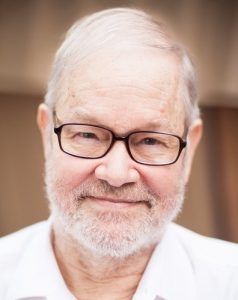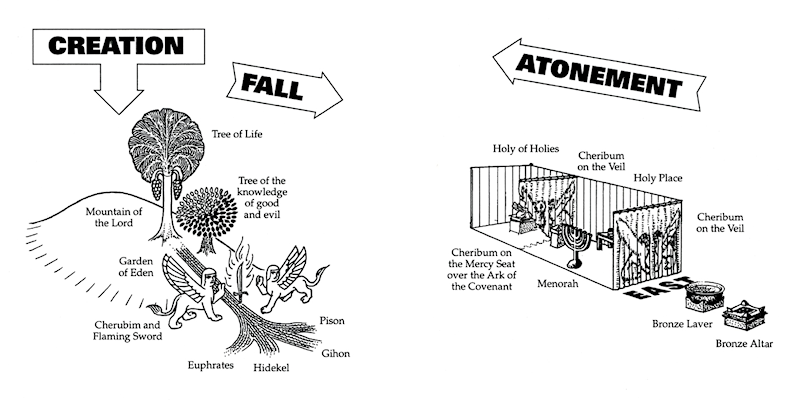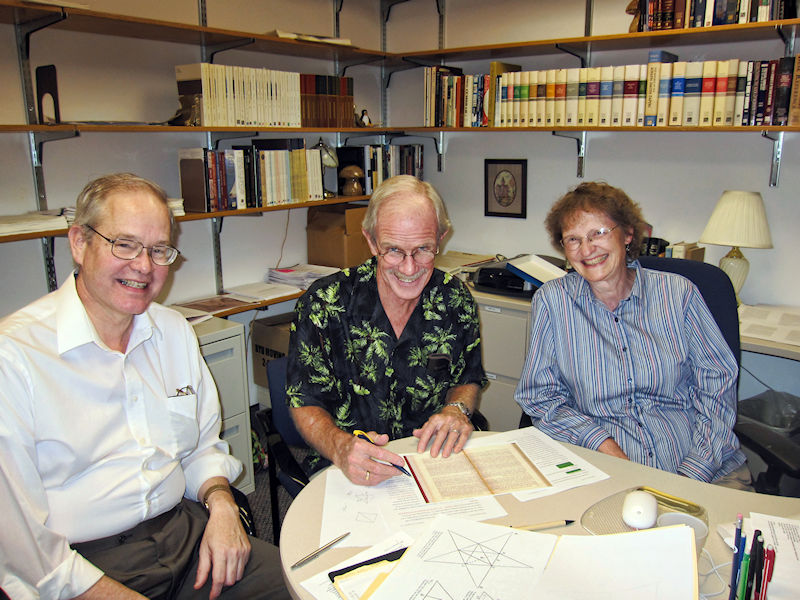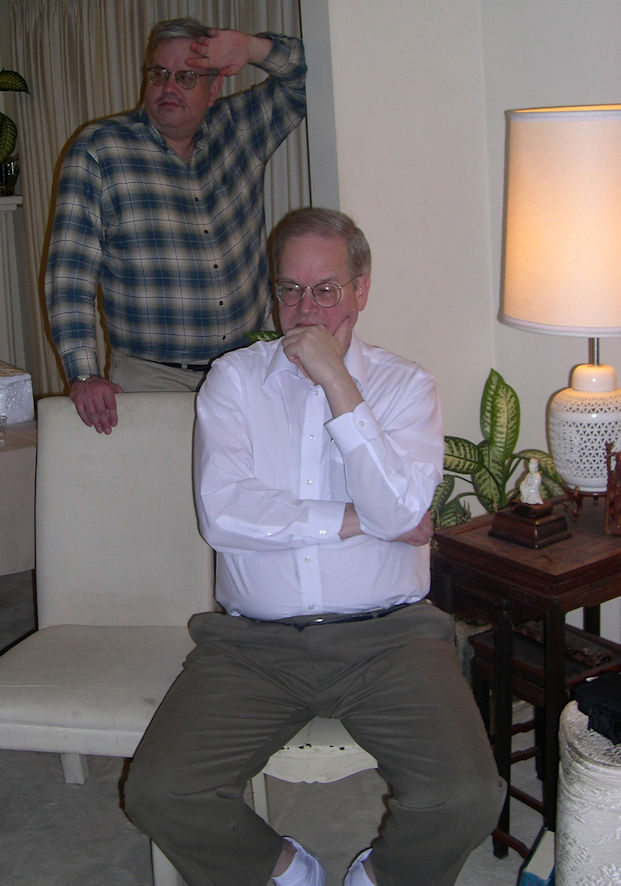
Michael Lyon, 1952-2022
Unfailingly kind, intellectually enthusiastic and gifted, and wholly unconcerned with personal recognition, he was generous with his time and his remarkable expertise, which extended far beyond art and art history to both East Asian and Middle Eastern antiquities and religious thought. I first met Michael at the end of the 1970s or early in the 1980s. He impressed me from the first. But one of my most memorable experiences with him was when he took me and my wife through BYU’s blockbuster 1995-1996 exhibit on the “Imperial Tombs of China.” Then as always, he was a fountain not only of helpful information but of fascinating and original insight. He made the exhibit come absolutely to life for us.
Now, Michael’s passing reminds me of the funeral of Hugh Nibley, who was a life-changing influence in his life, as it was in mine and in the lives of many of our mutual friends. Hugh had also suffered through an extended period of illness and debility before his release into the next life. So we all laughed when one of his daughters, speaking at his memorial service, admonished us to “put the fun back in funeral!” Her father had been eager to pass on for some time, she recalled, and she imagined that his response, upon waking up on the other side, was “Yee-HAW!”
I suspect that Michael’s response was much the same. A faithful Latter-day Saint, he has now been released from this world into what we’re told is a world of inexpressible beauty. As an artist, he’ll be in heaven—not only literally, but figuratively. And, I would add, it will be a world of fascinating people who have gone before—with some of whom Michael will be joyfully reunited and with others of whom he’ll be eager to meet. Those will be wonderful conversations. I wish I could eavesdrop on them!
In the brief paragraphs below, John Gee (holder of the William [Bill] Gay Research Chair at BYU), Donald Parry (Professor of Hebrew Bible and Dead Sea Scrolls at BYU), Shirley S. Ricks (formerly the production editor of the Collected Works of Hugh Nibley and now a member of the Interpreter Foundation’s Board of Trustees), and David R. Seely (Professor of Ancient Scripture, BYU) remember our friend, whom we already miss and for whom we are deeply grateful.
Dan Peterson

Gary Gillum’s copy of Nibley’s “Message.”
Michael’s words to Gary are now a fitting tribute applied to himself.
Jeff Bradshaw
Years ago, my friend Michael Lyon persuaded me to come with him to an art show. The prospect of going through an art show with an artist like Michael was intimidating. While I expected him to analyze the technical expertise of the artists (and he did), he explained his view of art in a way that I could relate to. He said that in approaching a work of art, you do not ask first about the proficiency. First you ask yourself, “Do I like this?” If the answer is “No” then it does not matter what sort of artistic ability the artist has brought to the task, you can move on. Only if you like the art do you need to consider the skill of the artist. It was not the attitude one expects of an artist.
Michael was a meticulous and extremely talented artist. He knew the techniques and how and when to use them, but he also valued beauty and simplicity. He was also deeply interested in the content and messages of the artwork. As someone who primarily worked in illustration, he wanted the illustration to convey not only the intent of the ancient artist whose models he followed but also the intent of the modern author whose work he illustrated. It was a feature of his own integrity and humility. Another feature was that, rather than impart his illustrations with his particular style, he had the ability to mimic the style of the ancient artists and to let the focus be on them, rather than himself. He was always willing to step out of the spotlight.
Michael was the principal illustrator for the Collected Works of Hugh Nibley and tried, by his artwork, to draw the reader into Nibley’s thought. Like Nibley, Michael’s knowledge was encyclopedic. His specialty was the Far East, but one would scarcely know that from his illustrations of Classical and Near Eastern art. He seemed to know everything about the art and culture of any time and place in the world and a great deal about the languages of those cultures, too. Most of all, he knew about the Gospel of Jesus Christ and could see how it applied to every aspect of life, and he tried to conform his life to it.
John Gee
I came to know Michael quite well in 1993, as he was preparing illustrations for the volume Temples of the Ancient World: Ritual and Symbolism, which would be published by Deseret Book in 1994. For this volume, Michael created dozens of amazingly powerful illustrations together with insightful captions. These illustrations, together with his other creative works that were published in the Hugh Nibley Collected Works and elsewhere, continue to impact thousands and tens of thousands of readers.
Because of Michael’s unique and significant contributions to Temples of the Ancient World, I wrote the following dedication in the book’s Introduction:
“I wish to thank the dedicated and faithful LDS scholars who devoted so much time, energy, and insight into the research, writing, and public presentation of the papers that form this volume. Special thanks are also due to Michael Lyon, whose love of the temple and diligent study of its ancient forms are reflected in the illustrations that he gathered and created. Together we hope that from the contents of this volume, LDS readers will gain a greater appreciation for the temples of old and, at the same time, come to more fully understand the temples of the present era as revealed through Joseph Smith, the first Prophet of the Restoration.”
To complete my tribute to Michael, I am pleased to share two of Michael’s illustrations. The first illustration was published in Temples of the Ancient World, in an article titled “Garden of Eden: Prototype Temple” (pages 126–151; the illustration is on pages 134–135):

This illustration has greatly impacted me and helped me to better comprehend how the Garden of Eden exhibited qualities that would later exist in the Tabernacle of Moses and other Israelite temples. Additionally, I better understand the important concepts of Creation, Fall, and Atonement, thanks to Michael’s illustration.
The second illustration (shown below), to the best of my knowledge, has never been published (at least, in this exact form). Michael shared it with me a couple of years ago, when I was writing another book on the temple. This illustration depicts the ark of the covenant, with the two poles (used to carry the ark), the ark itself (Hebrew ’aron), and the two cherubs. Note that Michael skillfully depicts the cherubs as females!

To conclude this tribute to my long-time friend Michael Lyon, I wish to cite a statement by another illustrator, Norman Rockwell, who wrote, “Some people have been kind enough to call me a fine artist. I’ve always called myself an illustrator. I’m not sure what the difference is. All I know is that whatever type of work I do, I try to give it my very best. Art has been my life.” Art has been Michael’s life and we have all been greatly blessed because of his life! And generations yet unborn will continue to benefit from Michael’s amazing contributions.
Donald Parry
This is an appropriate time in which to share some memories of working with my good friend Michael Lyon on the illustrations for the Collected Works of Hugh Nibley. Michael was, in my mind, the best religious iconographer in the Church. Michael’s first brush with the genius of Nibley came in his high school years when he skipped his own classes at Provo High to go up to BYU to sit in on some Nibley class lectures.
His direction of the illustrations for the Collected Works, which meant that he literally researched and drew most of them and composed their captions, began with The Ancient State. By the time we got to Temple and Cosmos, Michael had really warmed up to the task and was flooded with ideas for images that would clarify and elucidate Nibley’s text. He began by carefully reading the manuscript for a given volume and making notes for possible illustrations. My task was to sit down with him and craft a list of proposed illustrations and to say no as gently as I could when I felt the number of illustrations was excessive and might delay a book indefinitely. Often, when I would regretfully tell Michael we couldn’t use one more picture, he would reply, “Well, it will be in my copy.” His ambition seemed to know no bounds.
Perhaps typical of someone with an artistic temperament, Michael let several deadlines come and go. At times it seemed to us that no progress was being made, but Michael was extremely meticulous in his research. At times he showed genuine excitement when he “serendipitously” came up with the very illustration that Nibley was describing in the text. Finally, when the push was really on, the illustrations began to dribble in. Occasionally he drafted other individuals to help with the illustrations, but mostly he wanted to honor Nibley by doing the work himself. Michael would visit the Nibleys and present his suggestions—he was always relieved when Nibley approved the figures.
If a given illustration called for perspective of a building or some other object, Michael would often build a model, take pictures of it, and proceed from there. He was a perfectionist—even when something looked adequate to our eyes, he would redo something until he was satisfied.
When we neared the end of a project, Michael and I would sit down to compose the figure captions. We worked on them, often rewriting them until Michael was satisfied that all the pertinent details had been mentioned and until I was satisfied that they were as concise and succinct as possible.
And what never ceased to amaze me was when Michael would enhance later volumes by identifying earlier illustrations that were applicable so we could add a reference to that in a note. I hope you join with me in extending my thanks to Michael Lyon, a genuinely gentle soul, for greatly improving the value of the Collected Works through his illustrations and insights.
Shirley Ricks

Michael Lyon, Mike Rhodes, and Shirley Ricks collaborating on Nibley’s One Eternal Round, 2009
Michael Lyon was my friend in every sense of the word. We shared common loves and interests and we loved to travel and visit museums together. And we loved to sit in Brother Nibley’s classes and take notes. And we both loved everything ancient, the Temple, art, music and jokes. Michael Lyon was a gentle soul who dedicated his life to the search of truth, beauty, and goodness. He pursued truth with his keen and observant mind through his studies, and his wide reading. Michael sought beauty wherever he went. He was a gifted artist, which means he was able to create beautiful things: paintings, sculpture, calligraphy, temple models and objects. He loved many and had a sweet sense of humor. He was able to look past the foibles of people to see and celebrate the goodness he found in everyone. He was always willing to share his talents with others and there are many pieces of his art, calligraphy and crafts in homes scattered throughout the Wasatch Front. Michael was always engaged in discovering something new and wonderful.
I loved that Michael Lyon knew so much about almost everything. In the summer of 1980, I had the chance to travel across the country with Michael and Todd Compton in Todd’s yellow Volkswagen in celebration of the sesquicentennial anniversary of the Church. On this trip we attempted to visit all of the Church History sites as well as every major museum in between. We quickly learned in the Kansas City art museum that when you visit a museum with Michael you have to make an effort to keep moving—otherwise you would never get past the first room! Michael knew so much about everything: eastern art and mythology, Egyptian art and culture, Mesopotamia and the biblical world as well as the western art traditions of Greece, Rome and medieval and Renaissance Europe. So he could help us to understand many, many things and how they were connected. And then everywhere he could find vestiges of the various traditions of temple worship and religious imagery that were somehow connected and ultimately had some significance for us as Latter-day Saints.
I was always jealous that Michael was a personal friend of Hugh Nibley and they delighted in sharing their temple insights. Throughout his life Michael contributed illustrations for numerous scholarly articles depicting ancient Israelite temples and temple traditions that have appeared in LDS and non-LDS scholarship. He was especially involved in the illustrations of Nibley’s Egyptian Endowment volume and his final work One Eternal Round.
In 2004, I went with Michael Lyon, Bill Hamblin, Gary Gillum, and a few other students to sing Happy Birthday to Hugh Nibley on his 94th birthday. We had a grand time meeting briefly with Hugh, while singing and sharing treats. Brother Nibley was confined to his bed — a sad thing for me to see since I was used to seeing him constantly in motion. He noted his lost ability to move as he would like. Then he said something like the following with a smile, “I can’t wait to get to the other side! There we will be made whole, and we can continue to learn and grow and everything will become clear to us. I can hardly wait.” More and more each day, I take comfort in his cheerful countenance in the face of the debilitating effects of illness and old age.
I will miss Michael Lyon as my friend. Often in years past Michael would stop by our home on his way walking home from BYU. He always had his black briefcase and inside he always had a special new treasure to show us. Sometimes it was a new piece of art or calligraphy he was working on, sometimes a new scholarly article he had discovered, sometimes a small gift for our children. This exemplified the spirit of Michael Lyon, who saw life as a vast treasury of wonderful things to explore, to savor and to share. Slowly my friends, including Michael, are transferring to the other side, and I continue to hope that our friendships will continue when I rejoin them there in the future.
David R. Seely

Michael (with his brother Phillip in the background) at the Nibley wake on 26 March 2006



I can’t express in a few words how much Michael and his friendship has meant to me over the past several decades. But I’ll share a few things.
[I refuse to refer to Michael in the past tense, because a spirit as brilliant and gifted as his is continuing to live, though not among us.]
I have been privileged to know Michael since the 1980s, as we worked together on preparing the Nibley volumes for publication. He is one of the most talented people I have ever known, both conspicuously in the visual and plastic arts, but also in the subtlety and intensity of his mind. He has been a true friend to me. My fondest memories of Michael were when he came to visit me in New York City while I was in grad school, and he stayed for several weeks while I was in Central Asia. There never was a more considerate houseguest. When I returned, not only were my bookshelves logically and pleasingly re-organized, but he also had labelled, in his beautiful artistic hand, the spines of all of my xeroxed books! He also made a huge enlargement of the Manti Temple doorknobs, which he was researching while in Manhattan. They are a stylized Arabic depiction of the cosmos, with stars, planets, and crudely rendered Arabic labels. In their subject they are appropriate for the temple, but also of great interest to me, who was doing a PhD on the history of Arabic astronomy. The piece has graced my wall for decades now, and I would love to donate it to someone who would continue to appreciate it, whether a member of Michael’s family, or a museum, or archive.
Every conversation I ever had with Michael was mind-expanding–he has a broad vision of what is important and significant in our lives on Earth, and he imparted that vision to everything he did while sojourning among us. He is an easy man to love, because he was so full of love himself.
“And with the morn those angel faces smile, which I have loved long since, and lost a while.”
I miss you, Michael.
I was deeply saddened to hear of Michael’s passing. He was a close friend for many years. I first met Michael in the Ancient Library room in the Herald B. Lee Library. We became close friends. I was struck by his breath and depth of knowledge. Michael was always generous with his time and talents. While I was at BYU, I always enjoyed going with Michael to the Museum of Art. His keen observations and his unique gift for seeing patterns were amazing. I went with Michael several times to the Imperial Tombs of China exhibit and each time I learned something new. When I moved to California, Michael came multiple times, and we were able to visit various exhibits at the Getty Museum and the Getty villa. The last exhibit I saw with him at BYU Museum of Art was about the different paintings of Christ. It was memorable!
I will never forget Michael’s generous time and effort in helping me design my wedding cake and the backdrop with a tree of life motif. He made the concepts that we had discussed into reality. I am grateful for the books he inscribed for me with beautiful calligraphy.
Throughout the years we would talk often. I always cherished our conversations. Every time I would talk to him, I would learn something new and feel inspired. Whether in person or over the phone, I always felt a better man for having spent time with Michael. He had the gift of making the veil a bid thinner. Michael was able to connect different cultures and civilization. His spiritual insights, made this world and the next “one eternal round.” Michael’s illustrations greatly enhanced the writings of Hugh Nibley, of whom he always spoke as a mentor.
I saw how he showed a genuine interest in everyone he met by asking them questions. Michael was always very humble. I witnessed how kindly he would treat his mother after her stroke, with great love and affection. His eyes would light up as he would talk about his mother or with respectful love as he told tell stories about his father. I had the honor of meeting both of his parents who were kind and gracious. Michael embodied the same characteristics. He was a gentle soul. Michael had a great smile, and he would laugh with great joy.
I will always cherish my friendship with him. Michael’s departure has left a great void. I will miss him greatly. I will never forget him! Goodbye my dear friend till we meet again!
With Deepest Sympathy and Condolences to his family and friends,
Behzad Tabatabaei
I am so grateful to have had Michael as a friend. I wrote my tribute to him as a blog post. https://www.patheos.com/blogs/welcometable/2022/07/michael-lyons-quiet-life/